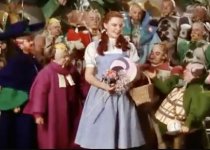Wizard Of Oz fans have noticed a continuity error in the original film after flocking to watch it following the release of the musical prequel, Wicked.
During a scene between the film's leading lady Dorothy - played by Judy Garland - and the scarecrow [Ray Bolger] viewers noticed a change in her appearance.
Midway through the scene, Judy's hair changes and her plaits grow from being shoulder length to grazing her stomach in a glaring blunder.
After spotting the marked difference in Judy's hair during the same scene, fans have flocked to social media to share the spot with their followers.
'I cant believe I never noticed that'; 'I swear I've seen this like, 100 times and NEVER noticed'; 'It was brushed out during the course of the day'; 'Wow IDK any of this ty!'; 'I thought the hair length was different because it took so long to make the movie';
'I have watched that movie I do not know many times but I never noticed that'; 'In those days they didn't have my job on set - script supervisors are responsible for keeping track of this'; 'I never noticed!! So glad I found u!!'


Celebrated for its pioneering use of technicolor, The Wizard of Oz was the most expensive movie ever made on its release – and, according to the US Library of Congress, it is the most-seen film of all time.
And yet, just like the wizard himself – eventually exposed as an ordinary man hiding behind a curtain and madly working levers – the making of the film was anything but magical.
In fact, The Wizard of Oz was so notorious for production disasters and controversies that some have mirthlessly observed the green-hued Wicked Witch of the West must have cursed it – before, that is, Dorothy doused her with a bucket of water and she melted.
Dorothy was memorably played by a teenaged Judy Garland, for whom making the movie involved anything but sexual empowerment.
Molested both by studio bosses and the Munchkins – natives of Oz – and forced to accept an oppressive regime to keep her weight down and look younger, her already shaky mental health never recovered as she descended into drug and alcohol abuse.
Her tragically premature death at only 47 – from an apparently accidental overdose of barbiturates while she was in London in 1969 – is widely blamed on the film's toxic legacy.
Garland had signed to Metro-Goldwyn-Mayer (MGM) production company at the tender age of 13, although her pushy mother had started giving her pills for energy, and to help her sleep, when Garland was just ten.
That insidious trend accelerated once she got into the clutches of a ruthless, slave-driving Hollywood studio.
MGM chiefs fretted continually about her weight and would deprive her of food, leaving her perpetually hungry.
One studio executive told her: 'You look like a hunchback. We love you but you're so fat you look like a monster.'
Another called her a 'fat little pig with pigtails'.
MGM's callous behavior left Garland with a life-long insecurity about her figure. She was seeing psychiatrists by the age of 18.
The studio even pushed drugs on the teenager (the fate of numerous other young stars) encouraging her to take amphetamines, known in the business as 'pep pills', to keep her slim and energetic through a relentless filming schedule. MGM also gave Garland sleeping pills to calm her down at night.
'Speed her up, slow her down,' said a studio insider who boasted Garland was 'run like a clock'.
The studio's concern over her appearance increased when she was given the role of Dorothy, who is meant to be 12. Garland, who was 16 when she got the part and a year older by the time filming was over, was told she needed to lose 12 pounds.
Quite aside from a strict diet of chicken soup, black coffee, 80 (appetite-suppressing) cigarettes per day, diet pills and more amphetamines, Garland had to wear a bizarre corset on-set which not only pulled in her stomach but held down her breasts.
Garland claimed – surely not seriously – that the contraption was made of iron.
Around the time she started making the movie, studio execs began molesting the actress, groping and endlessly propositioning her for sex.
MGM chief Louis Mayer liked to show that he thought she sang from the heart by putting his hand on the teenager's left breast.
'I often thought I was lucky that I didn't sing with another part of my anatomy,' Garland later recalled.
'Having sex with the female help was regarded as a perk of power and few women escaped the demands of Mayer and his underlings,' Garland's biographer Gerald Clarke observed.
Victor Fleming, one of five directors brought in to make the movie over five months of shooting, once tired of Garland's failure to stop laughing while shooting a scene and slapped her in the face. He, at least, was ashamed of his behavior and told the crew to punch him in the face in return, only for Garland to kiss him instead.
The diminutive actors hired to play the munchkins could not have reached her face to slap it, but they could, and allegedly did, put their hands up her skirts.
According to Garland, the adult thespians, who mainly suffered from dwarfism, were hardly the sweet and innocent race of 'Ozians' they portrayed on camera.
'They would make Judy's life miserable on set by putting their hands under her dress,' wrote Sid Luft, her former husband, in a 2017 posthumous memoir. 'The men were 40 or more years old. They thought they could get away with anything because they were so small.'
Although some have insisted they assaulted Garland, the munchkin actors have become mired in other notoriety over the years for their wild behavior.
After shooting finished, for instance, producer Mervyn LeRoy recalled how, 'they had orgies in the hotel and we had to have police on about every floor'.
During a scene between the film's leading lady Dorothy - played by Judy Garland - and the scarecrow [Ray Bolger] viewers noticed a change in her appearance.
Midway through the scene, Judy's hair changes and her plaits grow from being shoulder length to grazing her stomach in a glaring blunder.
After spotting the marked difference in Judy's hair during the same scene, fans have flocked to social media to share the spot with their followers.
'I cant believe I never noticed that'; 'I swear I've seen this like, 100 times and NEVER noticed'; 'It was brushed out during the course of the day'; 'Wow IDK any of this ty!'; 'I thought the hair length was different because it took so long to make the movie';
'I have watched that movie I do not know many times but I never noticed that'; 'In those days they didn't have my job on set - script supervisors are responsible for keeping track of this'; 'I never noticed!! So glad I found u!!'


Celebrated for its pioneering use of technicolor, The Wizard of Oz was the most expensive movie ever made on its release – and, according to the US Library of Congress, it is the most-seen film of all time.
And yet, just like the wizard himself – eventually exposed as an ordinary man hiding behind a curtain and madly working levers – the making of the film was anything but magical.
In fact, The Wizard of Oz was so notorious for production disasters and controversies that some have mirthlessly observed the green-hued Wicked Witch of the West must have cursed it – before, that is, Dorothy doused her with a bucket of water and she melted.
Dorothy was memorably played by a teenaged Judy Garland, for whom making the movie involved anything but sexual empowerment.
Molested both by studio bosses and the Munchkins – natives of Oz – and forced to accept an oppressive regime to keep her weight down and look younger, her already shaky mental health never recovered as she descended into drug and alcohol abuse.
Her tragically premature death at only 47 – from an apparently accidental overdose of barbiturates while she was in London in 1969 – is widely blamed on the film's toxic legacy.
Garland had signed to Metro-Goldwyn-Mayer (MGM) production company at the tender age of 13, although her pushy mother had started giving her pills for energy, and to help her sleep, when Garland was just ten.
That insidious trend accelerated once she got into the clutches of a ruthless, slave-driving Hollywood studio.
MGM chiefs fretted continually about her weight and would deprive her of food, leaving her perpetually hungry.
One studio executive told her: 'You look like a hunchback. We love you but you're so fat you look like a monster.'
Another called her a 'fat little pig with pigtails'.
MGM's callous behavior left Garland with a life-long insecurity about her figure. She was seeing psychiatrists by the age of 18.
The studio even pushed drugs on the teenager (the fate of numerous other young stars) encouraging her to take amphetamines, known in the business as 'pep pills', to keep her slim and energetic through a relentless filming schedule. MGM also gave Garland sleeping pills to calm her down at night.
'Speed her up, slow her down,' said a studio insider who boasted Garland was 'run like a clock'.
The studio's concern over her appearance increased when she was given the role of Dorothy, who is meant to be 12. Garland, who was 16 when she got the part and a year older by the time filming was over, was told she needed to lose 12 pounds.
Quite aside from a strict diet of chicken soup, black coffee, 80 (appetite-suppressing) cigarettes per day, diet pills and more amphetamines, Garland had to wear a bizarre corset on-set which not only pulled in her stomach but held down her breasts.
Garland claimed – surely not seriously – that the contraption was made of iron.
Around the time she started making the movie, studio execs began molesting the actress, groping and endlessly propositioning her for sex.
MGM chief Louis Mayer liked to show that he thought she sang from the heart by putting his hand on the teenager's left breast.
'I often thought I was lucky that I didn't sing with another part of my anatomy,' Garland later recalled.
'Having sex with the female help was regarded as a perk of power and few women escaped the demands of Mayer and his underlings,' Garland's biographer Gerald Clarke observed.
Victor Fleming, one of five directors brought in to make the movie over five months of shooting, once tired of Garland's failure to stop laughing while shooting a scene and slapped her in the face. He, at least, was ashamed of his behavior and told the crew to punch him in the face in return, only for Garland to kiss him instead.
The diminutive actors hired to play the munchkins could not have reached her face to slap it, but they could, and allegedly did, put their hands up her skirts.
According to Garland, the adult thespians, who mainly suffered from dwarfism, were hardly the sweet and innocent race of 'Ozians' they portrayed on camera.
'They would make Judy's life miserable on set by putting their hands under her dress,' wrote Sid Luft, her former husband, in a 2017 posthumous memoir. 'The men were 40 or more years old. They thought they could get away with anything because they were so small.'
Although some have insisted they assaulted Garland, the munchkin actors have become mired in other notoriety over the years for their wild behavior.
After shooting finished, for instance, producer Mervyn LeRoy recalled how, 'they had orgies in the hotel and we had to have police on about every floor'.








